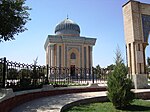Abd al-Ghani al-Nabulsi
Abd al-Ghani al-Nabulsi | |
|---|---|
| Born | عبدالغنی بن اسماعیل النابلسی
Abd al-Ghani al-Nabulsi 19 March 1641 |
| Died | 5 March 1731 (aged 89) |
| Known for | Muslim Scholar, Sufi |
Shaykh 'Abd al-Ghani ibn Isma′il al-Nabulsi (an-Nabalusi)[1] (19 March 1641 – 5 March 1731), was an eminent Sunni Muslim scholar and Sufi, was born in Damascus in 1641 into a family of Islamic scholarship. His father, Isma'il Abd al-Ghani, was a jurist in the Hanafi school of Sunni Islam and a contributor to Arabic literature. The family was Damascene, but came originally from Nablus and Jerusalem.[2]
Before the age of 20 he was teaching and giving formal legal opinions (fatwa).[1] He joined both the mystical orders Qadiriyya and Naqshbandi,[3] and spent seven years in isolation in his house studying the mystics on their expression of divine experiences.[1] He taught in the Umawi Mosque in Damascus and the Salihiyya Madrasa, becoming renowned throughout the region as an accomplished Islamic scholar. He travelled extensively, seeing Istanbul (1664), Lebanon (1688), Jerusalem (1689), Palestine (1689), Egypt (1693), Arabia (1693), and Tripoli (1700).[1]
He died and was buried in Damascus in 1731 at 90 years of age.
His works

He left over 200 written works.[1] His views on religious tolerance towards other religions were developed under the inspiration of the works of the 13th century Sufi master, Ibn Arabi. He made two visits to Palestine, in 1690, and 1693-4, visiting Christian and Jewish sites, as well as sacred Muslim shrines, and he enjoyed there the hospitality of local Christian monks.[2] Subjects he wrote about include Sufism, Rihla, agriculture, and poetry.[3] He also wrote ethnographic works based on his travels to Tripoli, Egypt, Jerusalem, Lebanon and other areas of the Middle East.[1][4]
- Idâh al-Maqsud min wahdat al-wujud ("Clarifying What is Meant by the Unity of Being")
- Sharh Diwan Ibn Farid (Commentary on Ibn al-Farid's Poetry)
- Jam'u al-Asrâr fi man'a al-Ashrâr 'an at-Ta'n fi as-Sufiyah al-Akhyar (Collection of the secrets to prevent the evils castigate the pious Sufis)
- Shifa' al-Sadr fî Fada'il Laylat al-Nisf Min Sha'bân wa Layllat al-Qadr (Curing the heart on the Virtues of the night of Nisfu Sha'ban and The Night of Qadr)
- Nafahat al-Azhar 'Ala Nasamat al-Ashar, a badī‘iyya in praise of the Prophet, 'no doubt' inspired by 'A'isha al-Ba'uniyya's al-Fatḥ al-mubīn fī madḥ al-amīn (Clear Inspiration, on Praise of the Trusted One); both writers accompanied their respective badī‘iyyas with a commentary.[5]
- al-Sulh bayn al-ikhwan fi hukm ibahat al-dukhan, an influential legal treatise advocating the lawfulness of smoking tobacco; ed. Ahmad Muhammad Dahman (Damascus, 1924).
- Ta‘tir al-anam fi tafsir al-ahlam, ed. Taha 'Abd al-Ra’uf Sa‘d, 2 vols. (Damascus, n.d.)
- al-Haqiqa wa al-majaz fi al-rihla ila bilad al-sham wa misr wa al-hijaz, edited by Ahmad 'Abd al-Majid al-Haridi (Cairo, 1986) is the longest rihla. This rihla also goes by the title al-Rihla al-kubra and covers over 500 folios in minuscule. The journey began on Muharram 1005/ September 1693 and ended with the Hajj 388 days later.[6]
- al-Hadra al-Unsiyya fî al-Rihla al-Qudsiyya, also called al-Rihla al-wustd focuses on al-Nablusi's trip to Palestine, specifically Jerusalem and Hebron.[6]
- Nihayat al-murad fi sharh hadiyyat Ibn al-'Imad, a treatise on the rites of prayer; ed. ‘'Abd al-Razzaq al-Halabi (Limmasol, 1994).
- al-Hadiqa al-nadiyya: Sharh al-tariqa al-muhammadiyya, 2 vols. (Lailbur, 1977).
- Hillat al-dhahab al-ibriz fi rihlat Ba'albak wa-al-Biqa' al-'aziz, often known as al-Rihla al-Sughrd, was the first of al-Nabulsi's rihla. It describes a 15-day journey to Lebanon in AH 1100/ AD 1688.[6]
- al-Tuhfa al-Nabulusiyya ft 1-rihla al-Tarabulusiyya was his second rihla, describing a 40-day trip across Lebanon to Tripoli.[6]
- Kitab 'ilm al-malahah fi 'ilm al-falahah[4]
- Book of Dreams Kitab al Manam[7][8][9]
References
- ^ a b c d e f "Abd al-Ghani". Encyclopædia Britannica. Vol. I: A-Ak - Bayes (15th ed.). Chicago, Illinois: Encyclopædia Britannica, Inc. 2010. pp. 14. ISBN 978-1-59339-837-8.
- ^ a b Abdul Karim Rafeq, 'Abd al-Ghani al-Nabulsi:Religious Tolerance and 'Arabness' in Ottoman Damascus,' in Camille Mansour and Leila Fawaz (eds,),Transformed Landscapes: Essays on Palestine and the Middle East in Honor of Walid Khalidi, American University in Cairo Press, 2009 pp.1-17.
- ^ a b "The Book of Elegance in the Science of Agriculture". World Digital Library. 3 April 1854. Retrieved 16 July 2013.
- ^ a b "Commentary to 'Abd Al-Ghanī Al-Nābulusī's Kifāyat al-ghulām". World Digital Library. 1877. Retrieved 16 July 2013.
- ^ W. A. S. Khalidi, 'AL-BĀ'ŪNĪ', in The Encyclopaedia of Islam, new edn by H. A. R. Gibb and others (Leiden: Brill, 1960-2009), I 1109-10 (p. 1109).
- ^ a b c d Sirriya, Elizabeth (1979). ""Ziyārāt" of Syria in a "Riḥla" of 'Abd al-Ghanī al-Nābulusī (1050/1641 - 1143/1731)". Journal of the Royal Asiatic Society of Great Britain and Ireland (2). Cambridge University Press: 109–122. JSTOR 25211052.
- ^ Elizabeth Sirriyeh, 2005, Sufi Visionary of Ottoman Damascus: ʻAbd Al-Ghanī Al-Nābulusī, 1641-1731 0415341655 p. 67 "... Muslim tradition of dream interpretation'.67 The work attracted Western scholarly attention from early in the twentieth century. 68 Nabulusi's famous book of dreams was the fruit of a."
- ^ Iain R. Edgar The Dream in Islam: From Qur'anic Tradition to Jihadist ...2011 0857452363 - Page 58 "However, in Islamic countries, al-Nabulusi's dream encyclopedia still is a popular dream interpretation book."
- ^ Yehia Gouda - Dreams and Their Meanings in the Old Arab Tradition 1419654020 2006- Page 419 According to Al-Nabulsi, in his alphabetical book of dreams the toilet represents the relief, welfare, and largesse of the household or, on the contrary, the hardships, poverty, and stinginess. It also alludes to the wife whom the dreamer takes ...
External links
- Barbara von Schlegell, "Sufism in the Ottoman Arab World: Shaykh ‘'Abd al-Ghani al-Nabulsi" (PhD diss., University of Pennsylvania, 1997.
- Smoking and "Early Modern" Sociability: The Great Tobacco Debate in the Ottoman Middle East (Seventeenth to Eighteenth Centuries)

